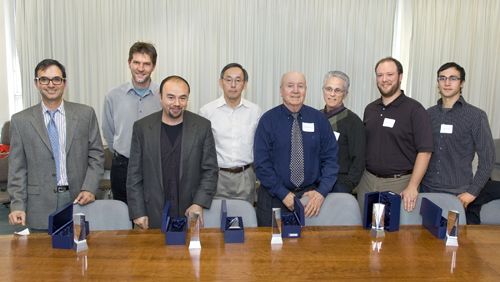 |
|
|
 |
|
From left to right, Natish Balsara, Jay Groves, Jonathan Maltz, Lab Director Steve Chu, Tom Budinger, Tamas Torok, Steven Hughes, and Bryce Sadtler. Missing from photo: Ted Chang, Paul Alivisatos and Richard Robinson. |
|
Ten Scientists Honored for Work Moving Technology to Marketplace
One project produced a non-invasive device to detect cardiovascular disease. Another featured an electrolyte that will boost the staying power of lithium batteries. And another resulted in a portfolio of nanotechnologies that might someday lead to more efficient solar cells.
“The wide diversity of inventions speaks to the strength we have here (at Berkeley Lab) in all areas,” said Director Steve Chu after he distributed 10 crystal trophies
to winners of the 2007 Excellence in Technology Transfer Awards. “It is a great tribute to this laboratory.”
The awards honored those researchers whose hard work and diligence this past year resulted in the licensing of products for the market. The recipients and their projects were:
- Tamas Torok, Life Sciences: In collaboration with DuPont's Crop Genetics Unit, Torok gathered extremophiles � microorganisms with special properties for survival under harsh conditions � in places like Chernobyl, the Ukraine, and tested their pest-resistent qualities for potential use in crop protection. The project resulted in 12 patent applications.
- Tom Budinger and Jonathan Maltz, Life Sciences: The pair came up with a non-invasive way to detect the early signals of possible cardiovascular disease. Their technique involves tracking the time it takes the pulse to travel to the main artery. A small startup in Texas licensed the technology.
- Nitash Balsara, Materials Sciences and Environmental Energy Technologies: A startup company in Berkeley has licensed Balsara’s new electrolyte that will extend the life of a lithium metal battery, with potential downstream uses in automobiles.
- Jay Groves, Physical Biosciences: Groves was honored for two projects. One is an improved biological bar-code assay, which is both sensitive and simpler to use. Applications include more effective testing of patient samples for indications of cancer or Alzheimer’s disease. And the second is a set of membrane-derived colloids that can determine whether a molecule is binding to a cell membrane. This knowledge could lead to successful drug candidates.
- Ted Chang, Environmental Energy Technologies: Chang developed a potentially cheap and efficient way of removing mercury from coal-fired power plant emissions. His technology has been licensed to the East Bay engineering firm Mobotec USA. Estimates are that this technique could remove 90 percent of the mercury at 50 percent the cost.
- Paul Alivisatos, Steven Hughes, Richard Robinson, and Bryce Sadtler, Materials Sciences: This nanoscience team and its products have already spawned three start-up companies through their discoveries of nanocrystal and nanorod solar cell advances.
Technology Transfer Department Head Cheryl Fragiadakis congratulated the honorees for helping science find its way “from the benchtop to the world of commerce.” One of Berkeley Lab’s success stories, Kasian Franks, also emphasized the importance of the tech transfer process to market applications. He and colleagues have started Seeqpod, a search engine technology company whose roots were in a patent at the Lab
-- Ron Kolb
|
 |

